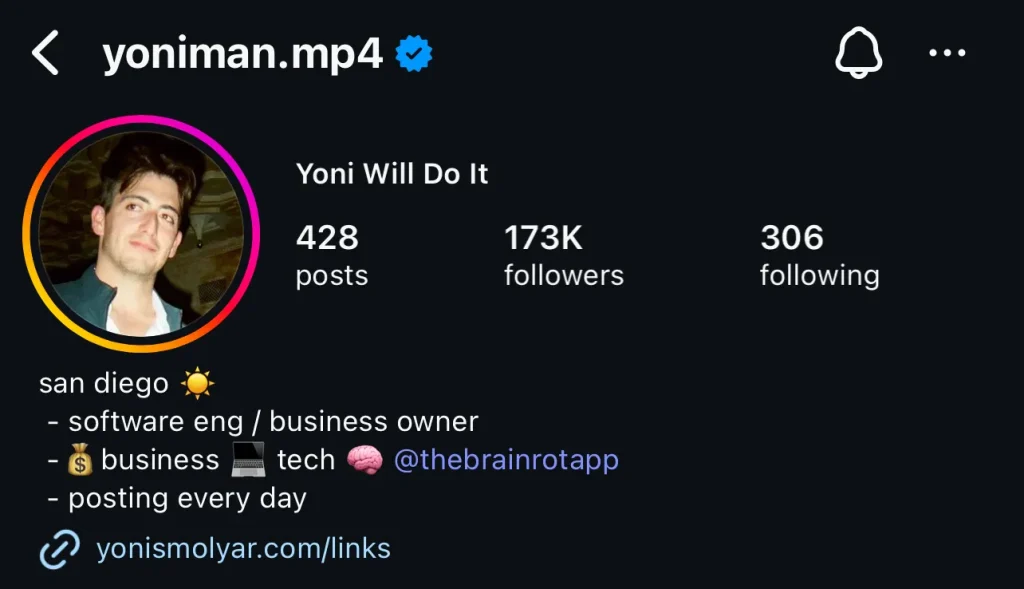Thirty days. One iPhone app. $26,000 in revenue. That is the eye-catching headline, the longer version features a first time app founder who calls himself a “serial starter,” a camera-shy engineer who posted a short video every day for more than four hundred days, and an idea born out of dopamine fatigue, rejection emails, and the creeping realisation that endless scrolling had quietly kidnapped his attention.
Before Brainrot, Yoni Smolyar did what many builders do, he started, he shipped, he stalled, and then he started again. After enough laps around that track he decided to try something that felt uncomfortable and therefore useful. He opened a fresh social account and began posting a daily mini vlog about what he was building and what was breaking. No tutorials, no guru wisdom, just the awkward, wobbly middle bits that most people crop out. By day nineteen one of those wobbly bits went viral and the following snowballed to more than two hundred thousand people across platforms. That audience would later become the difference between a launch and a lonely release.

Why Brainrot at all
Yoni is a content creator as well as an engineer, which means his phone loves him a little too much. Notifications kept tapping him on the shoulder and the infinite feeds kept offering just one more taste. He tried the usual screen time tools and did not fall in love, so he built the thing he wished existed. Brainrot is a minimalist screen time blocker with a slightly cheeky personality. A little cartoon brain tracks your daily decay as your usage climbs, a calendar keeps your history honest, and app blocking rules push you back toward the work you said you cared about.
Despite being a staff engineer by day, Yoni leaned hard on AI and the app was ninety percent vibe coded (his words, not mine!). From first commit to App Store took about two and a half months, which sounds brisk until you add the part where he scrapped and rewrote the app twice and collected six rejection emails from App Review like they were badges. He kept posting the painful bits and those posts kept performing, as it turns out the internet enjoys watching someone push a boulder uphill, especially when the boulder is currently rolling back down.
The marketing ‘plan’
Throughout the build he shared timelapses, snippets of code, and rejection screenshots, but he withheld the actual concept. Not because secrecy is a growth strategy, more because he wanted to launch the name Brainrot without a clone beating him to it. When the app finally dropped to his audience it did a few thousand downloads on day one and pulled in roughly $3,000 in revenue.
Next, without a big campaign or a cinematic trailer, he listed Brainrot on Product Hunt and went to sleep. By seven in the morning he was already sitting at number four and he pushed the launch to his followers, the votes stacked up, and the ranking ticked from three to two to one. That day alone delivered more than ten thousand downloads and about $5,000 in revenue. The following newsletters kept the party going and in the first thirty days Brainrot crossed $26,000 in revenue, and within the first few months total revenue pushed toward $40,000.
There is a romantic story where you burn the boats, stare dramatically at the horizon, and never look back but Yoni prefers a version where the rent gets paid, the pressure stays humane, and the learning compounds while you still have a desk somewhere. He argues that if you can make progress on nights and weekends then your job is not the blocker you think it is. Keep the income, build the product, practice distribution, and let the data tell you when to cross the river.

Competition, differentiation, and the myth of the brand new idea
Yoni’s bet was that a clear story, a tidy product, a memorable character, and direct access to an audience would win plenty of at-bats. Most users do not put your app through a procurement exercise. They see a clip, they tap the link, they skim the screenshots, and they decide in a heartbeat. You do not need to be the only option. You need to be the obvious option in the moment they are looking.
The repeatable playbook hidden in plain sight
- Start with a problem you actually have.
- Document the work as you do it.
- Pick one platform and ship faster than your perfectionism would prefer.
- Use your content as distribution, not as decoration.
- Launch somewhere that can compound attention, and give it a clean hook.
- Charge early, learn quickly, and only then decide if it is time to add Android, web, or a marching band.
Closing thought
There is a certain magic to internet money that shows up because you built a thing and some strangers decided it was worth paying for. Yoni’s story does not promise that magic, it shows the boring, teachable path that makes it more likely. Show up every day, tell the truth about where you are, ship something small that helps. Let the audience grow while the product improves and if you keep stacking those days, the neat little headline might eventually write itself.




